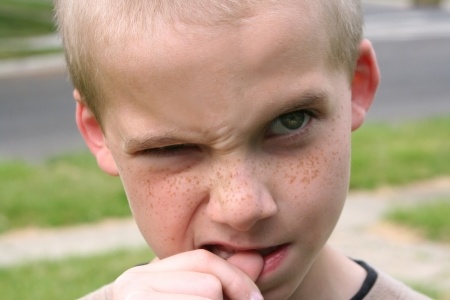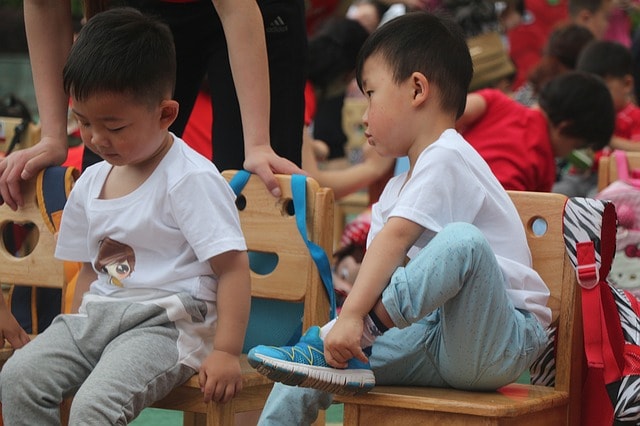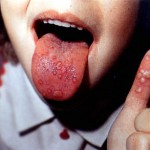Nail-biting is a common habit in children. Children nail bite for various reasons such as for comfort, to alleviate stress, when they are bored or out of habit. The inclination to nail bite can be learnt from watching others around them.
Nail biting is a type of nervous behaviour, falling in the same category as hair-twirling, teeth grinding and the like. There are times in growing up which can cause anxiety to children that may not be tangible to parents. Nail biting can also be triggered in response to events, such as exams, too much work or a transition such as a divorce, new school etc.

Should I be concerned?
Nail-biting is not a concern if done moderately and with no injury. Though unhygienic and annoying at times, it is the child’s way of managing stress. Some children eventually grow out of it. Adults also nail bite, when they are working on something difficult or when they are feeling a certain way. Indeed, a habit that makes one feel comfortable is tough to break!
⇒ Related Read: Signs That Your Kids Are Overworked And Stressed
Biting make the fingers prone to skin infections and may chip the front teeth. Severe or frequent nail-biting can be a cause for concern. Sore or bloody fingertips or nail-biting accompanied with other behaviours such as hair pulling may need further attention. In some cases, it may be due to excessive anxiety. Always seek medical consultation or professional help if the habit is extreme or may be representative of deeper issues.
What can be done?
Refrain from disciplining your child from nail-biting. Like some other bad habits such as leg-shaking, nail-biting is usually done unconsciously. Scolding or punishing is not really addressing the issue and may inflict additional stress. Nagging may stop the action momentarily but not for long.
Remember, it is very difficult for adults to break our own bad habits and even more so for children. They have limitations on expression of feelings and verbal capability and may not communicate their needs well. Try to be supportive and take a proactive and positive approach in helping your child break the habit of nail-biting is really getting to you.
- Understand your child
Talk to your child about what is bothering him or her. Observe the times when nail-biting occurs. Try to understand what triggers it.
- Draw attention to the habit
Help your child realise that he or she is doing it. It can be done like a game where a secret code or hand signal is used as a nail-biting alert.
- Teach
Explain nail-biting to your child. Discuss together the benefits of stopping nail-biting and how the habit can be broken. Teach ways to relax and encourage him or her to talk about stress. Consider cutting down on work and providing more time for relaxation, such as play or outdoor exercise.
- Keep good nail habits
Frequently clip your child’s nails and encourage good sanitation. Show that nails can be beautiful and clean if kept properly – for example, if one nail is unchewed while the rest are. For young kids, it may help to look at their nails often with them in an informal manner, such as relating the fingers as their 10 little friends.
Talk as if they have a relationship – “Oh, Jayden has been good to Mr Thumb”, “I am so sorry that little pinkie has been chewed on a lot”. Your child may be reminded of the friendship with his or her fingers the next time the urge to bite arises and may be more attentive to how far the nail-biting has gone.
- Substitute and set limits
You may encourage your child to wriggle his or her fingers when the urge to bite comes or twiddle the thumbs. The hands may be kept busy by engaging in a puzzle, building blocks, playing a musical instrument and the like. Limits can be a step in encouraging awareness such as no nail-biting when riding in the car.
- Praise
Explain to your child that it may be difficult to stop nail biting but you can help him or her with it. Provide comfort and offer praise when you notice less incidence of nail-biting. A sticker or reward chart may be a helpful motivator.
If something does not work, try other alternatives. Every child is different. Be on the same side with your child and provide assurance and affection regardless of the outcome. How one relates to the child should not be determined by the outcome of the habit. Last but not least, be patient and be patient!
⇒ Related Read: Top 5 Habits To Teach Your Toddler
By Som Yew Ya.
* * * * *
Like what you see here? Get parenting tips and stories straight to your inbox! Join our mailing list here.
Want to be heard 👂 and seen 👀 by over 100,000 parents in Singapore? We can help! Leave your contact here and we’ll be in touch.
























































